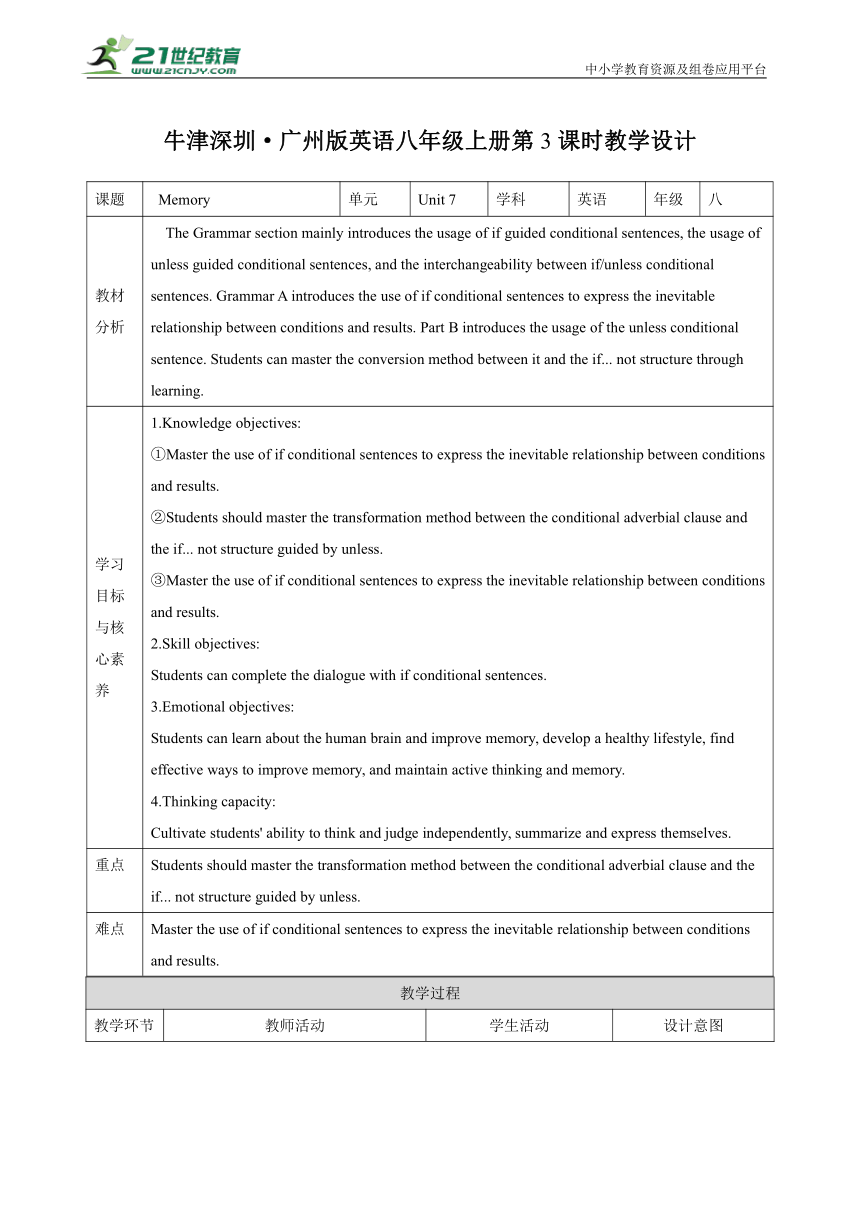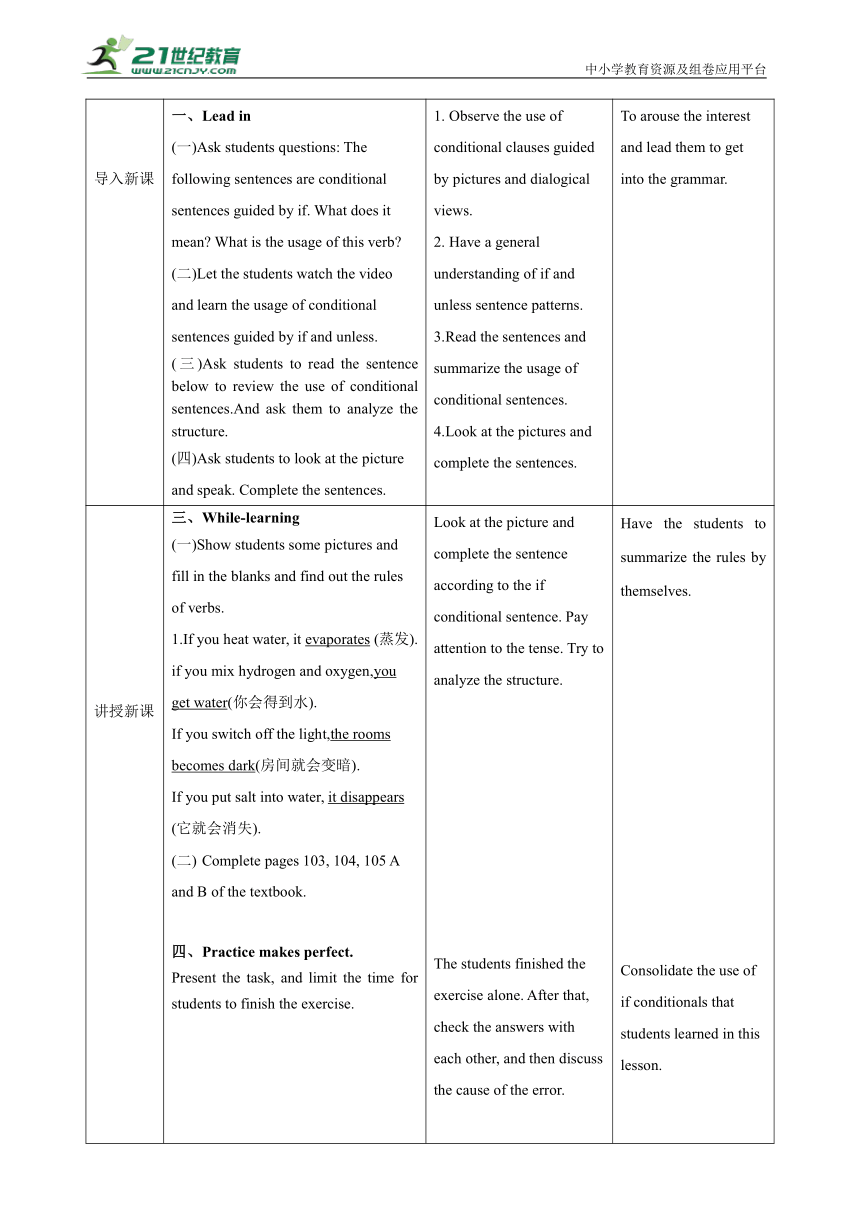【核心素养目标】Unit 7 Memory Period 3 Grammar 教案
文档属性
| 名称 | 【核心素养目标】Unit 7 Memory Period 3 Grammar 教案 |

|
|
| 格式 | docx | ||
| 文件大小 | 3.6MB | ||
| 资源类型 | 试卷 | ||
| 版本资源 | 牛津深圳版 | ||
| 科目 | 英语 | ||
| 更新时间 | 2022-11-22 15:23:28 | ||
图片预览


文档简介
中小学教育资源及组卷应用平台
牛津深圳·广州版英语八年级上册第3课时教学设计
课题 Memory 单元 Unit 7 学科 英语 年级 八
教材分析 The Grammar section mainly introduces the usage of if guided conditional sentences, the usage of unless guided conditional sentences, and the interchangeability between if/unless conditional sentences. Grammar A introduces the use of if conditional sentences to express the inevitable relationship between conditions and results. Part B introduces the usage of the unless conditional sentence. Students can master the conversion method between it and the if... not structure through learning.
学习 目标与核心素养 1.Knowledge objectives: ①Master the use of if conditional sentences to express the inevitable relationship between conditions and results. ②Students should master the transformation method between the conditional adverbial clause and the if... not structure guided by unless. ③Master the use of if conditional sentences to express the inevitable relationship between conditions and results. 2.Skill objectives: Students can complete the dialogue with if conditional sentences. 3.Emotional objectives: Students can learn about the human brain and improve memory, develop a healthy lifestyle, find effective ways to improve memory, and maintain active thinking and memory. 4.Thinking capacity: Cultivate students' ability to think and judge independently, summarize and express themselves.
重点 Students should master the transformation method between the conditional adverbial clause and the if... not structure guided by unless.
难点 Master the use of if conditional sentences to express the inevitable relationship between conditions and results.
教学过程
教学环节 教师活动 学生活动 设计意图
导入新课 一、Lead in (一)Ask students questions: The following sentences are conditional sentences guided by if. What does it mean What is the usage of this verb (二)Let the students watch the video and learn the usage of conditional sentences guided by if and unless. (三)Ask students to read the sentence below to review the use of conditional sentences.And ask them to analyze the structure. (四)Ask students to look at the picture and plete the sentences. 1. Observe the use of conditional clauses guided by pictures and dialogical views. 2. Have a general understanding of if and unless sentence patterns. 3.Read the sentences and summarize the usage of conditional sentences. 4.Look at the pictures and complete the sentences. To arouse the interest and lead them to get into the grammar.
讲授新课 三、While-learning (一)Show students some pictures and fill in the blanks and find out the rules of verbs. 1.If you heat water, it evaporates (蒸发). if you mix hydrogen and oxygen,you get water(你会得到水). If you switch off the light,the rooms becomes dark(房间就会变暗). If you put salt into water, it disappears (它就会消失). Complete pages 103, 104, 105 A and B of the textbook. 四、Practice makes perfect. Present the task, and limit the time for students to finish the exercise. 五、summary Introduce the concept, position, tense and other knowledge of conditional adverbial clauses guided by if and parisons between if and unless are interchangeable in general. Teach students the conditional adverbial clause song guided by if. Look at the picture and complete the sentence according to the if conditional sentence. Pay attention to the tense. Try to analyze the structure. The students finished the exercise alone. After that, check the answers with each other, and then discuss the cause of the error. Read and learn. Find out the rule individually. Take notes and finish the tasks. Have the students to summarize the rules by themselves. Consolidate the use of if conditionals that students learned in this lesson. Have the students to summarize the rules by themselves.
课堂练习 Present the task, and limit the time for students to finish the exercise. The students finished the exercise alone. After that, check the answers with each other, and then discuss the cause of the error. To consolidate what they have learned in this class.
课堂小结 The combination of pictures and videos is conducive to stimulating learning interest. The combination of various teaching methods makes the classroom content rich and students' knowledge comprehensively improved. Do more exercises to consolidate the form and usage of conditional sentences. Review the different uses of if and except. Review the tenses of conditional sentences. To make students have a good habit of taking notes and have a general understanding of this class.
板书 if引导的条件状语从句 概念 当表示客观事实、结果时,if条件句的主句和从句都用一般现在时。 二、主从句的位置 if 从句可以放在句首,也可以放在句末。如果把 if 从句放在句首,常用逗号将其与主句隔开。 三、主从句的时态 1.当表示客观事实、结果时,主句将从现。 2.将来可能出现的情况,主句将从现。 3.主句中含有情态动词,从句用一般现在时态。 4.主句为祈使句,从句用一般现在时态。 unless从句 一.时态 unless意为“除非”,和if…not(果 ……不……)的意思相近在unless引导的从句里,通常用现在时表示将来。 二.unless和if…not 用法 unless条件句,当所述条件会结束已经存在的想法,状态或趋向时,两个结构可以互换使用。 例:We shall go unless it rains tomorrow. =We shall go if it doesn’t rain tomorrow. 如果明天不下雨,我们就去。( “下雨” 会结束 “去” 这一已经存在的趋向) 例: They won’t come unless you say sorry.= If you don’t say sorry, they won’t come. 除非你道歉,否则他们不会来。 注意:unless用于引出某事发生或成立所必需的条件。 例:You should not promise anything unless you can do it. 除非你能做到,否则不要随便许诺。
21世纪教育网 www.21cnjy.com 精品试卷·第 2 页 (共 2 页)
牛津深圳·广州版英语八年级上册第3课时教学设计
课题 Memory 单元 Unit 7 学科 英语 年级 八
教材分析 The Grammar section mainly introduces the usage of if guided conditional sentences, the usage of unless guided conditional sentences, and the interchangeability between if/unless conditional sentences. Grammar A introduces the use of if conditional sentences to express the inevitable relationship between conditions and results. Part B introduces the usage of the unless conditional sentence. Students can master the conversion method between it and the if... not structure through learning.
学习 目标与核心素养 1.Knowledge objectives: ①Master the use of if conditional sentences to express the inevitable relationship between conditions and results. ②Students should master the transformation method between the conditional adverbial clause and the if... not structure guided by unless. ③Master the use of if conditional sentences to express the inevitable relationship between conditions and results. 2.Skill objectives: Students can complete the dialogue with if conditional sentences. 3.Emotional objectives: Students can learn about the human brain and improve memory, develop a healthy lifestyle, find effective ways to improve memory, and maintain active thinking and memory. 4.Thinking capacity: Cultivate students' ability to think and judge independently, summarize and express themselves.
重点 Students should master the transformation method between the conditional adverbial clause and the if... not structure guided by unless.
难点 Master the use of if conditional sentences to express the inevitable relationship between conditions and results.
教学过程
教学环节 教师活动 学生活动 设计意图
导入新课 一、Lead in (一)Ask students questions: The following sentences are conditional sentences guided by if. What does it mean What is the usage of this verb (二)Let the students watch the video and learn the usage of conditional sentences guided by if and unless. (三)Ask students to read the sentence below to review the use of conditional sentences.And ask them to analyze the structure. (四)Ask students to look at the picture and plete the sentences. 1. Observe the use of conditional clauses guided by pictures and dialogical views. 2. Have a general understanding of if and unless sentence patterns. 3.Read the sentences and summarize the usage of conditional sentences. 4.Look at the pictures and complete the sentences. To arouse the interest and lead them to get into the grammar.
讲授新课 三、While-learning (一)Show students some pictures and fill in the blanks and find out the rules of verbs. 1.If you heat water, it evaporates (蒸发). if you mix hydrogen and oxygen,you get water(你会得到水). If you switch off the light,the rooms becomes dark(房间就会变暗). If you put salt into water, it disappears (它就会消失). Complete pages 103, 104, 105 A and B of the textbook. 四、Practice makes perfect. Present the task, and limit the time for students to finish the exercise. 五、summary Introduce the concept, position, tense and other knowledge of conditional adverbial clauses guided by if and parisons between if and unless are interchangeable in general. Teach students the conditional adverbial clause song guided by if. Look at the picture and complete the sentence according to the if conditional sentence. Pay attention to the tense. Try to analyze the structure. The students finished the exercise alone. After that, check the answers with each other, and then discuss the cause of the error. Read and learn. Find out the rule individually. Take notes and finish the tasks. Have the students to summarize the rules by themselves. Consolidate the use of if conditionals that students learned in this lesson. Have the students to summarize the rules by themselves.
课堂练习 Present the task, and limit the time for students to finish the exercise. The students finished the exercise alone. After that, check the answers with each other, and then discuss the cause of the error. To consolidate what they have learned in this class.
课堂小结 The combination of pictures and videos is conducive to stimulating learning interest. The combination of various teaching methods makes the classroom content rich and students' knowledge comprehensively improved. Do more exercises to consolidate the form and usage of conditional sentences. Review the different uses of if and except. Review the tenses of conditional sentences. To make students have a good habit of taking notes and have a general understanding of this class.
板书 if引导的条件状语从句 概念 当表示客观事实、结果时,if条件句的主句和从句都用一般现在时。 二、主从句的位置 if 从句可以放在句首,也可以放在句末。如果把 if 从句放在句首,常用逗号将其与主句隔开。 三、主从句的时态 1.当表示客观事实、结果时,主句将从现。 2.将来可能出现的情况,主句将从现。 3.主句中含有情态动词,从句用一般现在时态。 4.主句为祈使句,从句用一般现在时态。 unless从句 一.时态 unless意为“除非”,和if…not(果 ……不……)的意思相近在unless引导的从句里,通常用现在时表示将来。 二.unless和if…not 用法 unless条件句,当所述条件会结束已经存在的想法,状态或趋向时,两个结构可以互换使用。 例:We shall go unless it rains tomorrow. =We shall go if it doesn’t rain tomorrow. 如果明天不下雨,我们就去。( “下雨” 会结束 “去” 这一已经存在的趋向) 例: They won’t come unless you say sorry.= If you don’t say sorry, they won’t come. 除非你道歉,否则他们不会来。 注意:unless用于引出某事发生或成立所必需的条件。 例:You should not promise anything unless you can do it. 除非你能做到,否则不要随便许诺。
21世纪教育网 www.21cnjy.com 精品试卷·第 2 页 (共 2 页)
